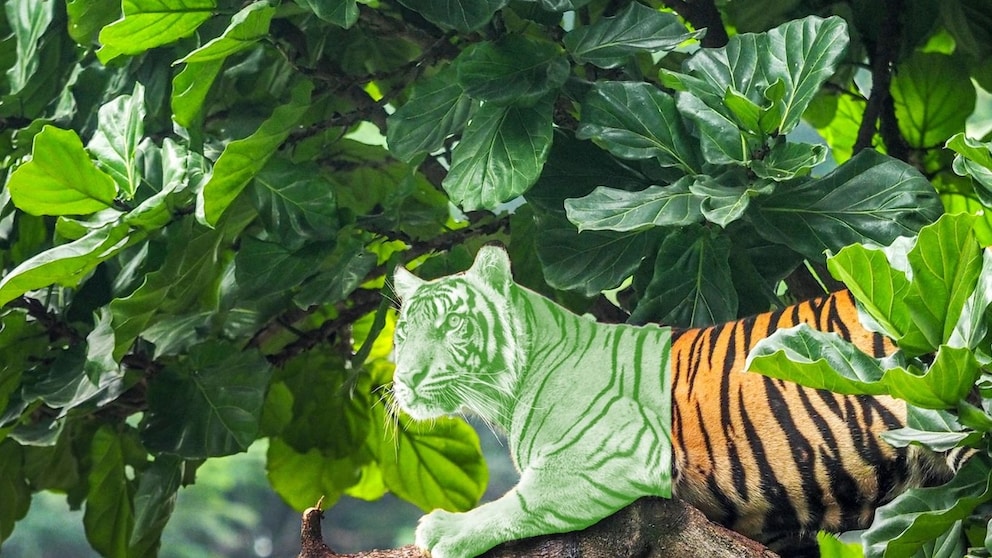February 11, 2025, 9:26 am | Read time: 4 minutes
Every child knows what a tiger looks like: orange fur with black stripes. But did you know that many animals – including the big cats themselves – perceive tigers as green? PETBOOK editor and biologist Saskia Schneider explains what’s behind it.
Tigers immediately catch our eye with their orange fur and black stripes. Some people may, therefore, ask themselves: how can it be that the animals sneak up on their prey unnoticed when you can see them sticking out of the green foliage from afar? But many animals see the world very differently from us. The tiger, for example, does not appear orange to its prey but green and thus has the perfect camouflage in the dense jungle. But how can this be?
Many Mammals Only See Two Colors
Most mammals – and tigers themselves – perceive fewer colors than humans. We have three color receptors, also known as cones, in our retina. These enable us to perceive the colors blue, green, and red. Most mammals only have two types of cones. This is also known as dichromatic vision. As a result, they perceive the world primarily in shades of blue and green but cannot see red. 1
But what does this mean in concrete terms? Here is an example: While for us, an orange ball stands out well visually against a green background, many animals – including dogs and cats – find it difficult to distinguish between shades of red and green. This is similar to red-green visual impairment in humans. For them, the orange ball in the green grass is difficult to make out straight away.
Dogs Can’t See Red Either
Incidentally, every dog owner can try this out for themselves with their four-legged friends because a surprising number of balls for dogs are orange or red in color. But not because our pets can see them well but because we humans can then find the ball particularly quickly in the grass.
When playing with a ball, dogs tend to orient themselves by its movement. Here, they are ahead of us humans in terms of vision. However, if the ball is stationary, they have problems locating it. Many owners then wonder why the dog can’t find the ball – after all, we can see the little round thing meters away! This is where dogs usually use their nose, as they can hardly tell the color of the ball from the color of the grass.
Why Can Only a Few Mammals See Red?
For us humans, our sense of sight is by far the most important. However, this is different for many animals. For dogs, for example, the sense of smell is the most important. For cats, in addition to smell, it is primarily the sense of hearing and touch. This means that blind cats often get along very well. Their other senses compensate for the loss of sight.
Because sight is so important for us humans, it was also an evolutionary advantage to develop trichromatic vision. Our ancestors already had this ability, and many great apes also have three cones in their retinas. However, we benefit from it when picking fruit, for example, as many plants use yellow and red tones to draw attention to their ripe fruit. Some animals, such as insects or reptiles, use these colors as a warning because they are poisonous.
This is Why Tigers Are Green For Many Animals
The tiger is like an orange ball. Many of its prey animals perceive its fur as greenish. As a result, it blurs into the foliage and bushes of the jungle, and the large cats of prey can sneak up on their prey undetected. This was even confirmed by a computer simulation in a 2019 study. English researchers created images of tigers as their prey perceive them. At first glance, the big green cats are barely recognizable. 2
But why aren’t tigers just “really” green? This would make creatures with trichromatic vision less likely to notice the big cats. John Fennel, head of the study, answers this question in the scientific journal, Livescience. Although green tigers would probably be even harder to spot, evolution simply doesn’t work with the ingredients needed to produce green fur. “Essentially, it’s easier to produce shades of brown and orange because of the biomolecular structure of the animal” than shades of green, the lecturer in animal sensory science and biometrics at Bristol Veterinary School explains.

Perception of Our Four-Legged Friends Can Dogs Watch TV?

Surprising Conditioning Dogs in India Prefer the Color Yellow to Food

Fact check Merely employees and can openers? How do our cats see us
Human Vision Is Unusual for Mammals
His colleague, Dr. Laszlo Talas, sums up: “The colors of nature don’t always make sense to us because we look at them with human eyes. The colors of animals should be judged in the context in which they live: their environment, their prey, their predators, and their mates.”
Fennel adds: “It’s worth remembering that human vision is very unusual in mammals. We have extremely sharp vision, and our eyes are trichromatic, which means we have three types of color receptors. Most other mammals are dichromats, with only two receptors that don’t allow them to distinguish green from red.” 3

